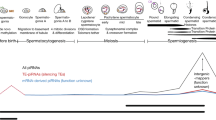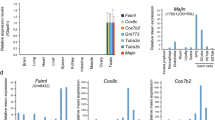Abstract
The objective of this study was to explore a novel method to alter the sex-ratio balance of mouse offspring by silencing the paralogous genes Zfx/Zfy (Zinc finger X/Y-chromosomal transcription factor gene) during spermatogenesis. Four recombined vectors PRZ1, PRZ2, PRZ3, and PRZ4 (RNAi-Ready-pSIREN-RetroQ-ZsGreen) were constructed for interrupting the Zfx gene. Additionally, a recombined vector Psilencer/Zfy-shRNA was constructed for interrupting the Zfy gene. Male mice were randomly divided into 8 groups, with 20 animals per group. Five groups of mice were injected with PRZ1, PRZ2, PRZ3, PRZ4, and Psilencer/Zfy-shRNA vectors, respectively. The three control groups were injected with an equal volume of physiological saline, empty RNAi-Ready-pSIREN-RetroQ-ZsGreen vector, and empty Psilencer/Zfy-shRNA vector, respectively. All groups were injected every 7 days for a total of four injections. Fourteen days after the fourth injection, 10 male mice from each group were mated individually with 10 females. Testicular tissue of 10 male mice in each group was collected, and the expression level of Zfx/Zfy mRNA was determined by qRT-PCR. Results showed that, compared with the empty RNAi-Ready-pSIREN-RetroQ-ZsGreen vector and the physiological saline group, expression of Zfx mRNA decreased significantly after injection of PRZ1 (p < 0.01), PRZ3 (p < 0.01), and PRZ4 (p < 0.01), and 78.75 ± 7.50% of the offspring were male in PRZ4 group, significantly higher than the offspring derived from the empty RNAi-Ready-pSIREN-RetroQ-ZsGreen vector and physiological saline group (p < 0.01). In the PRZ1 group, the expression of Zfx mRNA was also significantly lower (p < 0.01), but the male rate of offspring was not different (p > 0.05). Conversely, the expression of Zfy mRNA decreased significantly after injection of Psilencer/Zfy-shRNA (p < 0.01) and 31.00 ± 11.00% of the offspring were male, significantly lower than in the physiological saline group (p < 0.01). In conclusion, our findings show that RNAi-mediated disruption of Zfx/Zfy in mouse testis affected X/Y spermatogenesis. Additionally, results suggest that the paralogous genes Zfx/Zfy play an important role in the process of X and Y sperm development. The individual interference of Zfx/Zfy may predict the outcome of X and Y haploid sperms. Presented herein is an advanced method developed to control mouse X/Y spermatogenesis and sex ratio of offspring.


Similar content being viewed by others
References
Adler LD, Pacchierotti F, Russo A (2012) The measurement of induced genetic change in mammalian germ cells. Methods Mol Biol 817:335–375
Almiñana C, Caballero I, Heath PR et al (2014) The battle of the sexes starts in the oviduct: modulation of oviductal transcriptome by X and Y-bearing spermatozoa. BMC Genomics 15:1–11
Aoal A, Robert PE, Robert ML (1994) Transcription of paternal Y linked genes in the human zygote as early as the prenudeate stage. Zygote 2:281–287
Ashworth A, Skene B, Swift S et al (1990) Zfa is an expressed retroposon derived from an alternative transcript of the Zfx gene. EMBO J 9:1529–1534
Beneden ME (1870) Upon the mode of formation of the egg and the embryonic development of the Sacculinæ. Annals Magazine of Natural History 5:140–144
Cocquet J, Ellis PJI, Mahadevaiah SK et al (2012) A genetic basis for a postmeiotic X versus Y chromosome intragenomic conflict in the mouse. PLos Genet 8:1–15
Decarpentrie F, Vernet N, Mahadevaiah SK et al (2012) Human and mouse ZFY genes produce a conserved testis-specific transcript encoding a zinc finger protein with a short acidic domain and modified transactivation potential. Hum Mol Genet 21:2631–2645
Garner DL (2006) Flow cytometric sexing of mammalian sperm. Theriogenology 65: 943–957
Hansen MA, Nielsen JE, Tanaka M et al(2006) Identification and expression profiling of 10 novel spermatid expressed CYPT genes. Molecular Reproduction and Development 73:568–579
Jiang XH, Zhang H, Yin S et al (2014) Specific deficiency of Plzf paralog, Zbtb20, in Sertoli cells does not affect spermatogenesis and fertility in mice. Sci Rep 4:7062
Jukes TH (2000) The neutral theory of molecular evolution. GENETICS 154:956–958
Koopman P, Gubbay J, Collignon J et al (1989) ZFY gene expression patterns are not compatible with a primary role in mouse sex determination. Nature 342:940–942
Mardon G, Page DC (1989) The sex-determining region of the mouse Y Chromosome encodes a protein with a highly acidic domain and 13 zinc fingers. Cell 56:765–770
McCaffrey AP, Meuse L, Pham TT et al (2002) RNA interference in adult mice. Nature 418:38–39
McLaren A (1988) Sex determination in mammals. Trends Genet 4:153–157
Nadège V, Shantha KM, Yasuhiro Y et al (2014) Mouse Y-linked Zfy1 and Zfy2 are expressed during the male-specific interphase between meiosis i and meiosis ii and promote the 2nd meiotic division. PLoS Genet 10:1–15
North M, Sargent C, O’Brien J et al (1991) Comparison of ZFY and ZFX gene structure and analysis of alternative 3′ untranslated regions of ZFY. Nucleic Acids Res 19:2579–2586
Ollero M, Perez-Pe R, Gargallo I et al (2000) Separation of ram spermatozoa bearing X and Y chromosome by centrifugal countercurrent distribution in an aqueous two-phase system. J Androl 21:921–928
Page DC, Mosher R, Simpson EM et al (1988) The sex-determining region of the human Y chromosome encodes a finger protein. Cell 51:1091–1104
Palmer MS, Berta P, Sinclair AH 1990 Comparison of human ZFY and ZFX transcripts. Proceed Natl Acad Sci USA 87:1681–1685
Pamilo P, Bianchi N (1993) Evolution of the Zfx and Zfy genes: rates and interdependence between the genes. Mol Biol Evolut 10:271–281
Peng Q, Li RY, Jia B et al (2011) Sex control by Zfy siRNA in the mouse. Theriogenology 76:507–511
Peter M, Theresa Z, Robert PE et al (1994) Zfy is transcribed in the normal mouse epididymis and in the XXSxr (“sex reversed”) testis. Dev Genet 15:129–138
Sharp PA, Zamore PD (2000) RNA interference. Science 287:2431–2433
Tian L, Chen M, Peng JH et al (2014) Clinical characteristics, cytogenetic and molecular findings in patients with disorders of sex development. J Huazhong Univ Sci Technol 34:81–86
Tuschl T, Borkhardt A (2002) Small interfering RNAs: a revolutionary tool for the analysis of gene function and gene therapy. Mol Interv 2:158–167
Vernet N, Mahadevaiah SK, Decarpentrie F et al (2016) Mouse Y-encoded transcription factor Zfy2 is essential for sperm head remodelling and sperm tail development. PLoS ONE 11:1–15
Wilson EB (1905) The chromosomes in relation to the determination of sex in insects. Science 22:500–502
Windsor DP, Evans G, White IG (1993) Sex predetermination by separation of X and Y chromosome-bearing sperm. Reprod Fertil Develop 5:155–171
Wu N, Yu AB, Zhu Hb et al (2012) Effective silencing of sry gene with RNA interference in developing mouse embryos resulted in feminization of XY gonad. BioMed Res Int 2012:1–11
Yamauchi Y, Riel JM, Ruthing V et al (2015) Mouse Y-encoded transcription factor Zfy2 is essential for sperm formation and function in assisted fertilization. PLoS Genet 11:1–18
Acknowledgements
We thank HaiYan Lu for assistance with data analyses, as well as HongTao Li and Hong Shen for kind assistance with electron microscopy and accurate injection respectively. We thank LetPub (http://www.letpub.com) for its linguistic assistance during the preparation of this manuscript. The funding was provided by Science and Technology supporting XinJiang from Production and Construction Corps of ShiHeZi University, China (2014AB012).
Author information
Authors and Affiliations
Corresponding author
Additional information
YongSheng Zhang and JiFeng Xi contributed equally to this paper and should be regarded as co-first authors.
Electronic supplementary material
Below is the link to the electronic supplementary material.
Rights and permissions
About this article
Cite this article
Zhang, Y., Xi, J., Jia, B. et al. RNAi as a tool to control the sex ratio of mouse offspring by interrupting Zfx/Zfy genes in the testis. Mamm Genome 28, 100–105 (2017). https://doi.org/10.1007/s00335-017-9682-y
Received:
Accepted:
Published:
Issue Date:
DOI: https://doi.org/10.1007/s00335-017-9682-y




